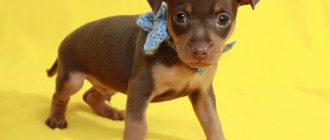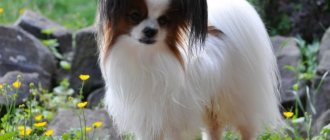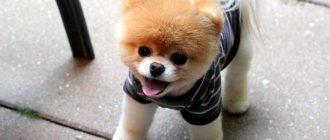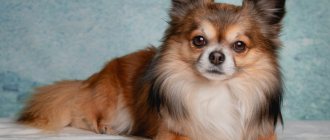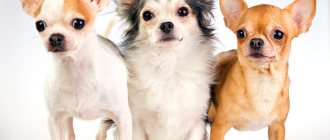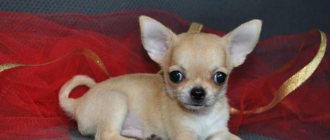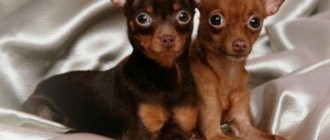If you are the happy owner of a purebred or show-class puppy, then participation in exhibitions definitely arouses your keen interest. Owners are often at a loss when it comes to preparing what seems like a very young child for such a serious and responsible event. However, if you confidently plan to enrich your pet’s biography by participating in exhibitions and winning more and more victories, you should train your puppy from his early “childhood”, starting from the simplest basics, gradually moving on to more complex tasks for the baby. In this article we will help you learn more about the exhibition “preparations” and put everything in order.
When should you start preparing for a dog show?
Dogs can enter the ring as early as 3 months. Puppies at exhibitions aged from 3 to 6 months are classified as baby class (“baby” from English - baby). This means that you should prepare your pet for an exhibition from 1.5-2 months, that is, almost from the moment the kitten is at your home. But still, you should let the baby get used to his new unusual place of residence; there is no need to give the puppy a kind of “shock therapy.” We recommend starting preparations after 7-10 days of your four-legged pet’s stay in your apartment.
Various Happy Legs Designs
If you have several dogs of different sizes or a puppy (who, of course, continues to grow), then an adjustable stand trainer is your option. For example, this: Option 1.
Thanks to the adjustable support positions in length and width, these happy leggings are very comfortable and can be easily adjusted to suit dogs of different sizes:
Option 2. Another model of an adjustable happy pet, built from bars on stiletto heels, which can “grow” with your pet.
Or “within”:
Option 4.
In handling halls they often use the simplest version of Happy Legs - two “bedside tables”.
During training on such a simulator, you will have to be more careful to ensure that the dog in the stance places its paws correctly - not too close, but not too wide.
In addition, each time you will need to “adjust” the happypick again in accordance with the “length” of your dog.
It’s great if you have the opportunity to show your dog on such happy leggings in front of the mirror. This will help you evaluate from the outside the parallelism of the paws.
How to touch a puppy?
Teaching your baby to be touched is not difficult. Stroke and touch the puppy; as a rule, cubs like to be “sniffed” in all sorts of ways. But often small puppies like to “bite” their owner’s palms in every possible way. Under no circumstances even think about teaching your baby such “games” if now they seem cute and funny to you. In the future, when bite marks from an adult dog are constantly present on your palms, this will no longer seem like fun entertainment to you.
However, in addition to regular touching, it is important to train your pet to show its teeth. To do this, say the command “teeth” and carefully, without ever causing pain to the dog, expose the upper and lower jaw with your hands. Probably, at first the restless little kitten will not really like this, and he will try to escape from your hands in every possible way. During the process, calm the baby with your voice; after the “procedure”, be sure to praise him and treat him with a treat. The main thing in this matter is calmness and practice. Repeat this manipulation with your pet regularly several times a day, and you will certainly notice how the puppy will gradually begin to get used to it.
Test of courage
German Shepherds over the age of 2 years undergo the so-called mutt test, or courage test, which consists of two stages: the surprise factor and the frontal attack.
Surprise factor
- The expert invites exhibitors to the starting line according to their numbers.
- The handler takes the starting position with the dog on a leash.
- The dog sits on the left side of the handler (owner, handler, trainer).
- At the judge’s command, the handler and the dog walk a few meters on a leash, giving the dog the command “near”.
- At the next command from the expert, the handler stops, unfastens the leash and, having given the dog the command “near”, continues moving.
- From a hiding place, the protection assistant (helper) attacks the dog, pushing the dog.
- The dog must react quickly without the handler’s command and repel the attack by grabbing the sleeve.
- After the grip, the helper makes three swings and three blows with the stack on the dog’s body.
- The dog should not let go of the sleeve and continue to fight.
- After stopping the helper, the judge gives a command to the dog’s handler and he must give the dog the prohibiting command “fu”, “no”, “give”, “aus” (optional), after which the dog must let go of the sleeve, but remain guarding the helper. If the dog does not release on the first command, two additional ones are allowed.
This exercise takes into account the dog’s courage, swiftness of attack, strength, depth and tenacity of the grip, the desire to fight and the clarity of the execution of the prohibiting command.
After the dog has released its sleeve, it must remain near the helper in the guarding phase (with or without barking), while it must be concentrated on guarding, must not turn towards the owner (handler), must not run around the helper and – Moreover, she should not leave the protected object until the conductor approaches and gives the command “nearby”.
If the dog is afraid, distracted, moves away from the helper or makes a weak grip, this is reflected in the evaluation of the exercise and affects the evaluation of conformation. If a protection exercise is poorly performed, the conformation grade for an anatomically excellent dog may be reduced to “very good,” “good,” or “satisfactory.”
A dog that shows fearlessness and excellent work in apprehension, but does not release the sleeve on command, cannot qualify for “selected excellent”, only “excellent” and is punished for this with a place in the ring.
Frontal attack
- After the surprise factor exercise, the dog and handler return to the start.
- At the judge's command, the handler unfastens the leash, holding the dog by the chain.
- From a distance of 40-50 meters, at the expert’s command, the helper begins to move towards the dog, depicting threatening behavior (swinging with a stack with sharp cries).
- With the permission of the judge, the handler releases the dog towards the defendant.
- The dog must not shy away from the swing, demonstrate fearlessness, strength, depth and tenacity of the grip, the active phase of the fight, and withstand a stack of blows to the body.
- After stopping the defendant, the judge gives a command to the handler and he removes the dog from his sleeve with a prohibiting command.
- Just as in the “surprise factor” exercise, the dog must release the helper no more than after the third command and remain in the guard phase, without being distracted by the handler, expert and others and without leaving the guard place until the handler approaches and the command is given “ near".
It is allowed to grab the dog by the chain, but at the same time it should not have time to grab again. The score for this exercise affects the dog's place in the ring and the show score in the same way as the score for the surprise factor.
Based on the test results, an overall score is given for both exercises, consisting of two criteria: grip score and release score. According to the classification, there are the following assessments of behavior testing: “expressed, releases”, “expressed, does not release”, “available/available, releases”, “available/available, does not release”, “insufficient”.
The “expressed” rating is assigned if the dog demonstrates fearlessness, self-confidence, good grip strength and tenacity, and is not distracted during the guard phase.
The rating “available” is assigned if there are restrictions on self-confidence and errors in the guard phase (the dog is distracted a lot by the handler, often looking back at him), runs around the helper, without maintaining a static position (sit, lie, stand) in front of the helper.
A rating of “insufficient” is assigned if the dog evades or runs away from a frontal attack, or leaves the guard phase from the helper.
How to accustom a puppy to strangers?
Undoubtedly, at the exhibition the baby will feel the touch of experts. Therefore, when the little kitten has a positive attitude towards the manipulations carried out by you, involve your partner, friends, and relatives. Your motto is still calm and patient. Explain to your charges that touches should be smooth and careful. Avoid using force and raising your voice, otherwise the baby will be intimidated.
Simply put, strangers should, according to your instructions, do the same with the baby as you do with him. And the main thing invariably remains practice, practice and more practice.
How to accustom a puppy to a collar and leash?
- introduce your baby to these objects, let him smell and study them;
- Carefully and without sudden movements, put the collar on the puppy, in no case tighten it too much. But do not remove it at the moment when the kitten may try to get rid of it. If you put the collar on correctly, but the puppy still tries to pull it off, it means it’s just unusual for him. Try to calm the baby down, distract him with a game or treat. A little time will pass and the baby will get used to the new lotion;
- When the puppy is finally accustomed to the collar, teach him to walk nearby. Do not rush to give him a strict command; first, you should teach your pet to move next to his left leg, actively walk and run after his hand with food, thereby developing food motivation. By the way, in the future the latter will become the “basis” of any further training of your puppy;
- At this stage, attach the leash to the collar and lower it to the floor. Let the baby just run around the apartment in this “equipment” and get used to the new attribute. But don't let your puppy chew on it, because the leash is by no means a toy;
- When the puppy has gotten used to it and no longer pays attention to the dragging leash, take the latter in your hands and walk with the baby. Do not tug or pull your pet; the leash should not be associated with coercion and discomfort. Guide the baby with light jerks, practice calling and moving next to you. Be sure to praise and feed your pet, then walking on a leash will be a pleasure for him.
Functions of the simulator for training the stance in dogs.
The main tasks that happypic helps to solve:
- helps to reduce the time during which the dog masters the show position,
- helps the dog feel the correct balance of the body,
- allows the animal’s muscle memory to fix the correct paw placement,
- develops the dog's endurance, obedience and ability to concentrate,
- creates a positive attitude towards work in the dog through positive reinforcement.
Further education and training of the puppy
When the baby has already mastered the “three pillars” of preparation for the exhibition, all that remains is:
- train the puppy to stand;
- train to be around other dogs.
Standing is a very difficult exercise for a restless little puppy. Therefore, to prevent him from becoming too bored, start with 5-10 minute sessions a couple of times a day.
Conduct classes in conditions that are convenient for both you and your baby. The floor should not be slippery, otherwise your four-legged friend’s paws will simply “blur” to the sides. Place a large mirror opposite your tandem with your baby, this will make it easier for you to monitor the correctness of your actions.
The puppy gets into a handstand with your help. You position your paws correctly, adjust the tilt of the baby’s head, posture, and tail position. Remember that all breeds have different stances, each has its own, with certain features and subtleties. You can find out about these very features of the stance of your puppy’s breed on the Internet, on forums, or personally ask the breeder about it.
Say the command “stand” and put the baby in the correct position. Of course, a fidget will quickly get tired of one stationary position, so while stroking, feeding and praising the puppy, hold it in one position for 5-10 seconds. Then release the pet and repeat the same algorithm a few hours later. Gradually increase the time of the stand, and gradually the puppy will calmly stand for half a minute.
With a free stand everything is much simpler. You don't have to put the puppy in the right position yourself. After you and your pet have run a circle around the ring (note that the baby should not jump and jump, he needs to trot smoothly next to your left leg), stop the puppy, commanding him to “stand.” The main thing here is to keep the kitten in this position. However, experts will understand that in front of them is a cheerful young puppy, and it is unlikely that they will “torture” the baby for more than one minute.
In the company of strange dogs, the puppy will certainly be very excited and will try to interact in every possible way with potential friends. This problem is solved by the baby's concentration on the owner. For this, food motivation, which was discussed a few paragraphs earlier, can come in handy. To prevent strange dogs and puppies from
clouded your pet’s mind, you should become more interesting to him than his newly made four-legged acquaintances. If the puppy is interested and pleasant with you, then, of course, his attention in the ring will be directed only to you. When the baby is in the company of other dogs, do not leave him alone with them in the hope that he will play enough with the same puppies, and your participation will not even be needed. In this way, you will only alienate your pet from you, thereby worsening his obedience. Exercise your puppy, challenge him mentally and physically, and don't forget to reward him with treats, play, touch and interaction. A dog that is interested in its owner will never disappoint you in the ring.
What are Happy Legs?
A dog stance training machine can be purchased on the Internet. Although, having the necessary materials, happy leggings are quite easy to make yourself.
Today there are many designs of happy pads, but the essence of all is the same - these are four non-slippery elevations for the dog’s paws, which allow you to reliably hold it in a static position.
Each paw support has a limited area, so the dog will not be able to step from paw to paw, mark time, jump, much less sit down. The dog turns out to be “fixed” in a position where its front and rear, as well as right and left paws are located clearly parallel to each other - on the same line.
Grooming a puppy
After your baby is fully prepared for the exhibition, all that remains is to tidy up his appearance. If you are the owner of a short-haired puppy, all grooming consists of washing your pet, trimming nails, cleaning teeth and ears. And if your baby has long and fluffy hair, you should pay special attention to care. The best option would be to entrust your pet’s grooming to a professional groomer. However, if you are confident in your abilities and want to independently prepare the puppy for the exhibition, be prepared to bother with styling his luxurious “fur coat.” Washing a long-haired baby won't be enough. The fluffy coat can take several hours to style. You need to be especially careful when caring for white dogs, from the very beginning of your pet’s stay at your home, since due to improper nutrition their snow-white coat will turn yellow. Also remember that the puppy itself must be in good shape, not skinny or overfed. A healthy dog always looks beautiful and well-groomed.
If you carefully follow the advice given in this article, then feel free to go to the exhibition with your baby pet! With good and careful preparation of the baby for such an event, your efforts are guaranteed to be worth it. We wish you success and reaching new heights together with your four-legged pet!
When did your pet first take part in an exhibition? We look forward to your comments!
Movement of a German Shepherd in the ring
To accustom him to movement at a special breed show, a special ring is made during training. To do this, fence off the outer perimeter of flat ground with a special tape, at least 20-30 meters long and 10-20 meters wide, at a height of 20-30 centimeters from the ground. At a distance of 1 meter from the outer border of the ring, lay the tape on the ground, securing it (at a height of up to 10-15 cm, until the dog gets used to moving exactly along the designated path), cutting off the corners so that you can turn left without injury.
In such a ring, the dog is taught not only the correct movements, but also to fulfill all the requirements of demonstration at the exhibition: examination of the teeth and testes, standing, moving forward and backward (to examine the parallelism of the limbs and assess the ligamentous apparatus), walking and trotting on a tight leash. .
During ring training classes, the German Shepherd must be wearing a special chain collar and a leash that matches its color (black or brown, not distracting attention from the dog itself), no more than 2 centimeters wide and 2.0-2.5 meters long.
- The optimal length of the leash is 2.0-2.15 meters, the material is soft leather 2 cm wide or nylon tape with latex thread of the same parameters.
- The chain collar can be made of white or yellow metal (yellow chains are more suitable for brightly colored dogs with a lot of black and intense tan towards red or brown).
- The design of the chains can vary, as can the configuration of the link.
- The length, link and color of the chain must be selected strictly individually.
- The chain, fastened like a collar, should be loose along the bottom of the dog’s neck, without falling onto the shoulders and withers.
A long chain, adjusted with a leash carabiner, with a dangling end or gathered into a lump with a carabiner, will look unpresentable, so it is better to choose the length individually for the dog. If you have already decided to take up an exhibition career, do not skimp on the little things.
Author of articles
Oksana Gromova
Practicing German Shepherd dog handler. 30 years of experience.
How should a German Shepherd move in the ring? In front of the owner/handler, on a slightly tensioned leash, the full length of the leash (2 meters), at a light, sweeping, creeping trot, counterclockwise. Even when a person walks in the ring at a walk, a well-built (with the correct movement apparatus) and well-trained German Shepherd moves at a trot! Galloping and ambling are unacceptable for demonstration in the ring; ambling is generally considered a movement defect. The dog should not pull excessively on the leash, falling on its front, breaking in the back, sprawling on the ground, and should not mince, jump, rush from side to side. The expert evaluates the productivity of movements (lightness, length of step, correctness of gait, stability at different paces) and the degree of controllability of the dog while moving.
At large single-breed exhibitions there is a lot of competition in terms of the quantity and quality of the individuals represented and the degree of their preparation, therefore, the degree of endurance of the dog will also be of no small importance. The examination in a large ring can last up to 1.5 hours (description and inspection of each exhibitor, comparison at different speeds of movement, shot testing, etc.) and the winners must remain fresh and cheerful, despite the weather conditions.
It is worth noting that specialized exhibitions of German shepherds are held in open stadiums, often in the summer, when it is hot and possibly raining. And you need to be prepared for anything! By the way, take care in advance of a cage with a cover or a box where the dog can rest before and after the ring and hide in bad weather, as well as in case of staying in a hotel and simply for ease of transportation.
In order for your dog to have a sufficient degree of endurance, train him with the same amount of time and quality of movement as you expect at the show. That is, a ring training session should consist of at least 1 hour of productive movements with rest in a standing position . At the same time, you yourself will be ready to work in the ring or outside the ring. I would like to note that sometimes it is much more difficult to work outside the ring than in the ring, since outside the ring a person must always be at least a quarter of a circle ahead of the dog with the handler. This is a very big load. If you are not sure that you will run out of the ring yourself, enlist the help of family members or friends who will go with you to the exhibition and help there too.
In the ring, the handler should not relax for a minute. While the expert is looking at the dog, demonstrate it as effectively as possible, while he is not looking, he quickly gives the opportunity to loosen the tension a little, go to a walk, and rest.
At the same time, the handler himself constantly watches the judge and as soon as he begins to shift his attention towards your dog, he collects himself as much as possible, gives a message to the dog and continues to move with full attention.
If your handler does not work according to this algorithm, change it. This means that this person does not set himself the goal of winning with your dog, but only wants to make money on it, without particularly straining. Unfortunately, today there are many of them. The work of handlers is well paid, they try to recruit the maximum number of exhibitors for the exhibition, literally in every ring, and the working class, which is the hardest in all respects, but also the last, is no longer able to do not only excellent, but simply decent work.
During training, the dog must be accustomed to special commands: “hop” - moving forward at a trot; “ring” - turn left at the corners of the ring; “stand” - fixation in a stance.
There is a certain set of gestures that the handler uses to communicate with the assistant behind the ring for a better demonstration of the dog:
- An outstretched hand raised upward is a request to the assistant to call the dog.
- Indicating the direction of movement with your hand is a signal to the assistant to quickly move in the indicated direction.
- Movement of one or both hands left and right is a “no” signal: no need to call, generally hide behind the audience.
- Waving your hand towards the handler is a request for the assistant to come over.
In a good team, a non-fooling handler has time to look not only at the judge, but also at the assistant and react to his gestures, previously agreed upon in training.
- I put the dog to the description - looked at the assistant and reacted: he nodded - everything is fine, the dog is standing well; The assistant shook his head left and right - it needs to be rearranged, something is wrong.
- The assistant showed his arms outstretched forward - the dog’s front legs need to be corrected, placed more straighter.
- He sat down on his knee and asked to indicate the angle of the dog’s knee.
- I depicted stroking the topline - somewhere the fur is bristling, it needs to be ironed.
The handler doesn’t react to your gestures, doesn’t look at you - drive him in the neck. So he doesn't care what your dog looks like. Moreover, it’s all for your money!
List of German Shepherd handlers who have proven themselves to be high-level professionals:
- Makeeva Elena, Ukraine, nursery “Li Anne Lur”
- Klyagina Yulia, Russia, nursery “Balaris”
- Smirnova Anastasia, Russia
- Omelchenko Irina, LPR, Forsthouse Rice nursery
- Sopilnyak Victor, Ukraine, nursery “Haus Visa”
- Sarana Sergey, Ukraine, nursery “Vollblat”
- Tishkova Tatyana, Ukraine-Russia
- Grubskaya Lyubov, Ukraine, nursery “from the Azov Coast”
- Cherednik Anna, Ukraine
- Davydova Marianna, Ukraine, nursery “Dzhenestra”
- Chuperka Katarina, Ukraine
- Silaeva Elena, Russia, nursery “Strong and Soft”
- Danilchenko Zlata, Belarus, nursery “vom Frosten”
- Belyakova Oksana, DPR, nursery “Ostlikh Ausval”
- Golubitskaya Elena, DPR, nursery “Stolz Vaterland”.
The list was compiled not according to the priority of the professionalism of the handlers, but simply as they were remembered. In essence, they are all equal professionals.
Exhibiting in a ring over 12 months will require you, in addition to showing skills, to also be in very good physical shape , so if you are not sure that you can run with your dog at different paces in a ring lasting up to 1-1.5 hours, find a suitable handler in advance.
